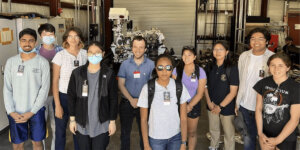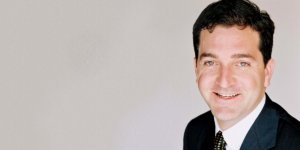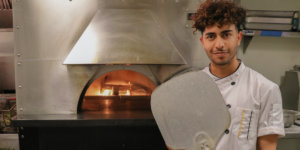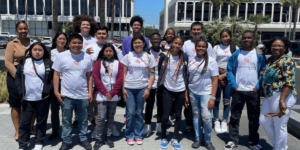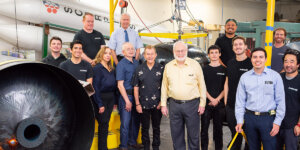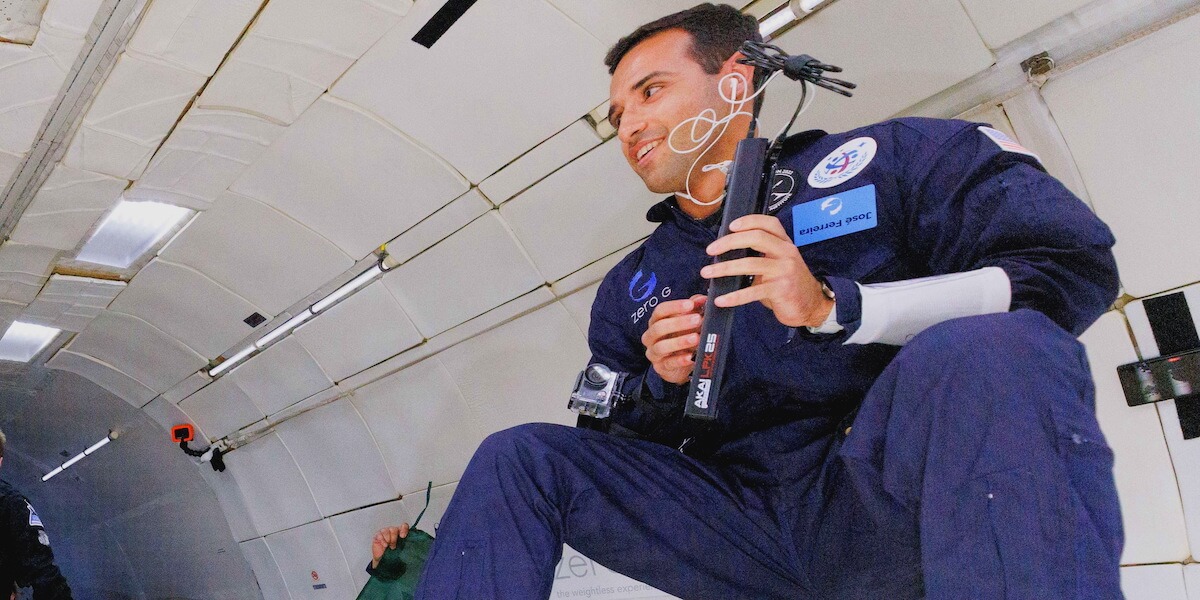
Jose Ferreira on board a Zero-G flight PhotoCredit: Steve Boxall/Zero-G
This past spring, Jose Ferreira debuted a new piano composition.
His audience: 24 other flying people — flipping upside down, spinning and nearly crashing into him as he played his electric keyboard.
The location: 34,000 feet in the air, on board a specially modified Boeing 727 as part of the Aurelia Gateway Program’s zero gravity flight.
For Ferreira, an astronautical engineering Ph.D. student at the USC Viterbi School of Engineering and a Fulbright Fellow, the experiment combined his passion for engineering with music, simultaneously. Growing up, Ferreira learned how to play the piano at just five years old – a moment he says significantly impacted his life.
“I started playing or learning music before I even started reading or doing math,” Ferreira explained, “so that’s mostly the reason why I thought of doing this music STEM-related experiment.”
Once he finished high school, Ferreira had to make a tough decision between pursuing music or engineering in college, both of which were his interests. Ultimately, while he chose to pursue an education in engineering, he always had the desire to figure out a way to combine his love for music with his engineering studies.
The idea for this experiment had always been brewing in Ferreira’s mind. Due to his interdisciplinary interests in music and STEM, he was waiting for the perfect opportunity to bring these two worlds together.
That moment came over the course of his studies at USC Viterbi as Ferreira took on a leadership role with the Space General Advisory Council, a global network of students and young professionals interested in space. This year, the Space General Advisory Council decided to partner with Aurelia Institute, a non-governmental organization (NGO), that runs the Aurelia Gateway Program to provide zero-gravity flights for research purposes.
After Ferreira was selected by the Space General Advisory Council to board a zero-gravity flight to participate in the Aurelia Gateway Program, his next task was finalizing and getting his project approved. This was his opportunity to meld together his love of engineering with his love of music. As is the case with any research project, there are always unanswered questions. Ferreira’s questions involved learning how sound-perception is impacted by a zero-gravity flight.
Thanks to his studies in astronautical engineering, Ferreira’s vast knowledge of the technical components behind zero-gravity environments was able to assist him in solving some of the challenges he faced. One of those challenges included understanding the proper size of the keyboard he should bring onboard the flight. Since the flight was zero-gravity, if he used a full-sized keyboard, it would have to be bound to a surface, thus eliminating the element of zero-gravity. A realization that helped him decide to use a small, handheld keyboard instead.
Ferreira also knew that because of the smaller keyboard, he would not be able to properly play certain pieces of music. Due to this constraint, Ferreira had Conservatório Regional de Setúbal, the Portuguese conservatory in which he trained, compose a custom piece of music for this flight.
“The piece, entitled “Parabola”, is composed of a blend of intervals and rhythms that mathematically relate to the word “Parabola”,” said Ferreira. “It does not abide by the standards of “classical music” we are used to. It is more like the atonal twelve-note serialism introduced by pioneers of the so-called Second Viennese School such as Arnold Schoenberg and Anton Webern.”
Click the video below to hear “Parabola”.
After working through the obstacles and figuring out the specifics of the project itself, it was time to plan. Ferreira flew to Boston, Massachusetts to begin preparations for the flight. A few days later, the Au Horizon 2022 Zero-G flight was ready to board with Jose Ferreira on it. Once aboard the zero-gravity flight, it was time to begin the project. But what did the zero-gravity flight feel like?
“The best comparison I can make to how it feels is like swimming,” Ferreira said. “In the videos, you can see me and other people trying to move our arms and legs, but that doesn’t work because the air is not dense enough for you to push it and have a reaction force in the opposite direction. It’s like swimming but you can breathe, and you go much faster in any direction if you were to push off a surface.”
Once he got used to the feel of the environment, Ferreira began playing on the piano. Because of the zero-gravity environment, he had to hold himself steady while playing. Sometimes, he even had to stop playing because he found himself moving and having to adjust.
“I think the biggest hurdle aboard the flight was that I was not able to consistently press the keys when I wanted, because I actually had to have one hand free to prevent myself from hitting others or surfaces.”
There was a lot going through his mind while in flight. In addition to completing this experiment, he also had to constantly be aware of his surroundings.
“A lot of things were going through my mind because you are seeing people float upside down, yet you had to concentrate on playing the keys and getting used to the zero-gravity environment.”
Despite the fact that there were many distractions, Ferreira was able to successfully execute the project and later evaluated his data. He found that while the tempo was not actually changing, and the clicks of the metronome from his phone stayed consistent, the zero-gravity component did impact the way in which he heard and reacted to the tempo. This opportunity to flip, soar, and play piano, as if he were in space, is one that Ferreira says he will not soon forget – not only because he combined his two passions, but because he hopes his research strikes a chord with others looking to learn more about music and engineering.
“My idea is to use the results from my experiment to open the door for future studies,” Ferreira says. “There are a lot of ways that music can be related to STEM, and this is just one of them, in which we can use auditory stimuli to measure how astronauts perceive and react to sounds throughout their missions.”
Published on October 4th, 2022
Last updated on October 4th, 2022




